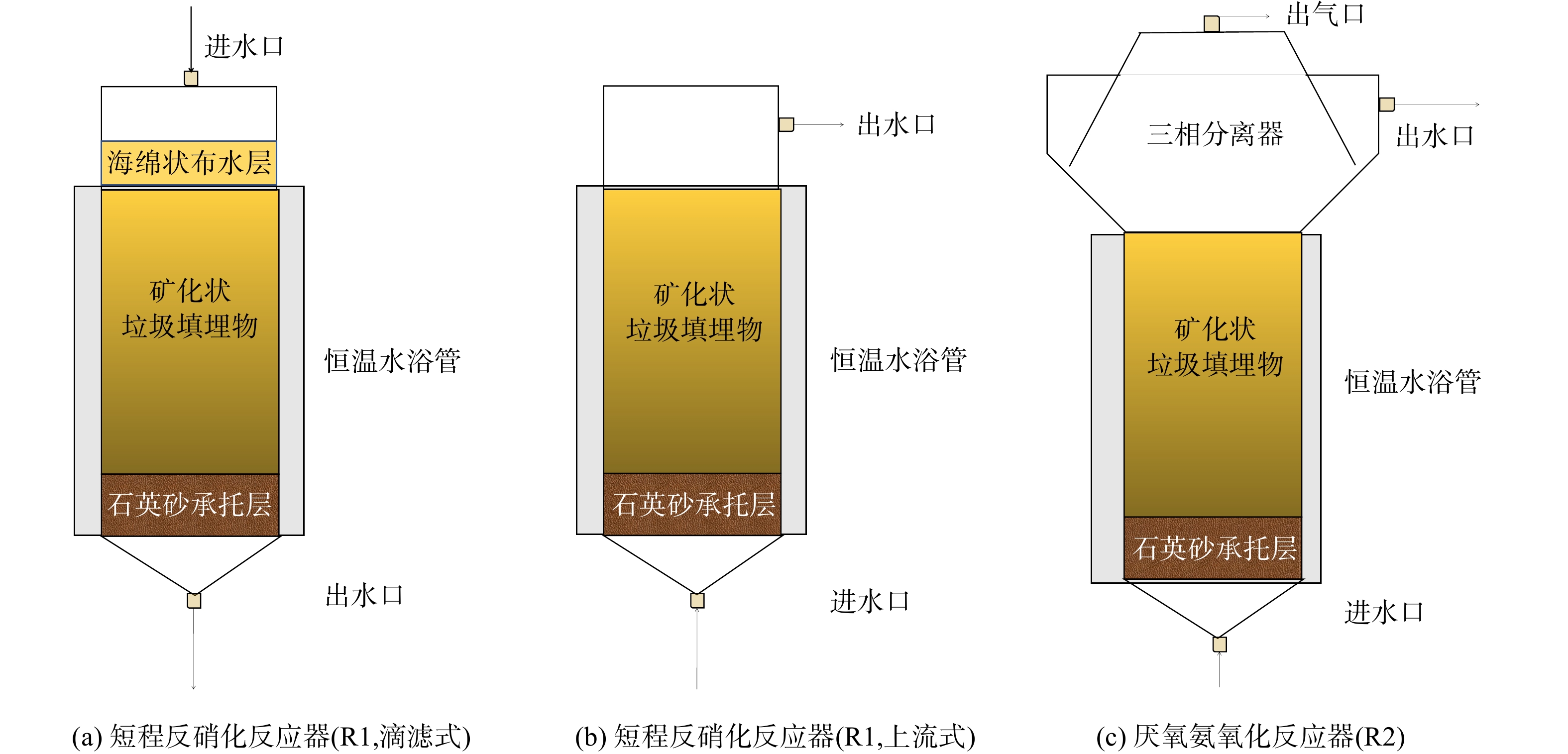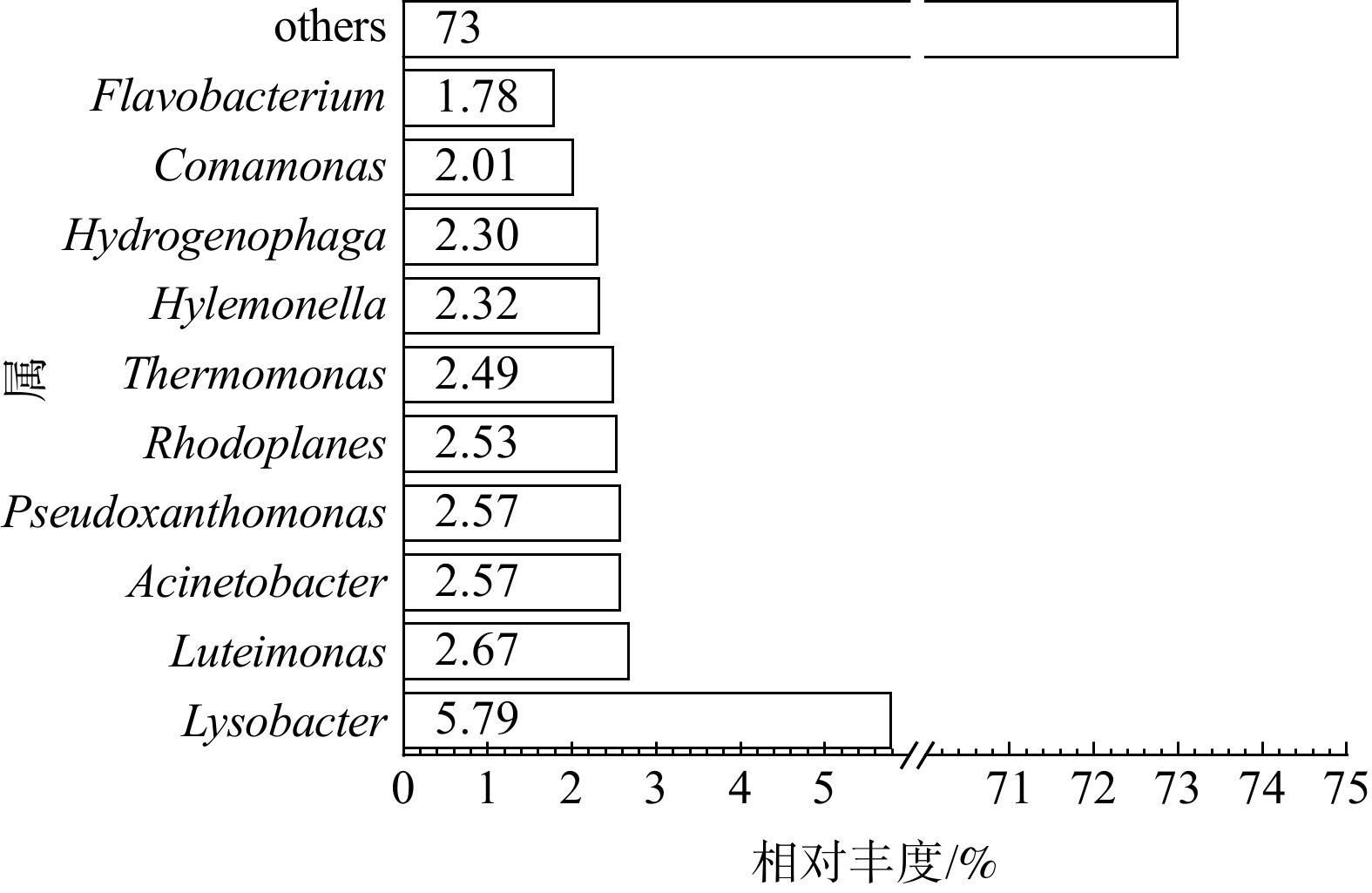-
随着经济社会的发展和城市化进程的加快,城市生活垃圾产生量与日俱增。预计到2030年,我国垃圾填埋物数量将达到峰值[1-2],其资源化利用已成为研究热点。在填埋场封闭的环境条件下,生活垃圾经过长期的物理、化学和生物稳定化过程后,由散发出恶臭气体的原生垃圾逐渐转变为性质和组分相对稳定、具有泥土气味的类土壤物质[3],呈现出矿化状特性。在长期厌氧、高盐、高毒等填埋稳定化过程中,矿化状垃圾填埋物中大部分可降解有机物已被去除,存留的微生物菌群理论上具有更强的环境适应性与污染物降解/转化性能;另外,矿化状垃圾填埋物的比表面积可达5.46 m2·g−1,具有良好的污染吸附能力及微生物附着能力[4]。因此,可考虑将其用作水处理填料并开发矿化垃圾填料床处理工艺,发挥其对污染物的微生物降解/转化能力和吸附能力。
厌氧氨氧化(anammox)工艺具有无需曝气和外加碳源、操作成本低且剩余污泥少等优势,已成为最具发展潜力的生物脱氮技术[5]。Anammox需要
NO−2 作为电子受体,且反应产生NO−3 ,而短程反硝化则将NO−3 还原为NO−2 ,可为anammox提供NO−2 ,同时可节省NO−2 继续还原所需的碳源,故短程反硝化和厌氧氨氧化受到广泛关注。低C/N氨氮废水中的NH+4 极易氧化为NO−3 ,导致NO−2 积累难,anammox工艺易受影响。矿化填料中的亚硝酸盐氧化菌(NOB)以Nitrospira sp.为主,这类菌株对氧气的亲和力很强[6],且当NH+4 转化为NO−2 后,Nitrospira sp.会随即利用多余氧气将NO−2 进一步氧化为NO−3 ,很难通过短程硝化作用实现NO−2 的积累。短程反硝化则可将NO−3 转化为NO−2 ,同时消耗水中有机物,避免其对后续anammox细菌发生抑制。综上所述,将短程反硝化耦合厌氧氨氧化工艺是低浓度、低C/N氨氮废水高效处理的重要选择[7]。本研究阐明了矿化状垃圾填埋物的理化性质,并以矿化状垃圾填埋物为填充物,分别研究了其短程反硝化性能和厌氧氨氧化反应器的性能,以期为其应用于低C/N氨氮废水的处理提供参考。
-
本研究所用的垃圾填埋物取自江西某填埋场的不同填埋单元,经8 a以上厌氧填埋,呈矿化状。自填埋场表面向下,每隔1 m设置1个取样点,最大深度为4 m。每个取样点采集50 kg样品,4个填埋单元,共计16个样品,并将这些样品混合均匀。取出填埋物质中大块的颗粒,如石块、玻璃、无纺布等。经过风干处理后的矿化状垃圾填埋物手动过筛(2 mm孔径)待用。
-
实验用水为模拟废水。(NH4)SO4和NaNO2分别为厌氧氨氧化过程提供相同质量浓度的NH4+-N和NO2--N,碳源由1 g·L-1的NaHCO3或KaHCO3提供。NaNO3为短程反硝化过程提供NO3--N,碳源由CH3COONa提供,其COD为50~400 mg·L-1。用0.1 mol·L-1的盐酸溶液将pH调节为(7.0±0.2)。
-
反应器均由有机玻璃制成,其结构如图1所示。其中,短程反硝化反应器(R1)分滴滤式和上流式两种进水方式,厌氧氨氧化反应器为R2。反应器外部由恒温水浴管包裹,温度控制为(35±1)℃。进水流量由蠕动泵控制。短程反硝化反应器(R1)内径为100 mm,高410 mm,总体积为3.4 L,有效容积为1.2 L,填料质量为3.7 kg。其中,滴滤式反应器(R1)从上到下包括进水口、海绵状布水层、矿化状垃圾填埋物、石英砂承托层及出水口;上流式反应器(R1),从上到下包括出水口、矿化状垃圾填埋物、石英砂承托层及进水口。厌氧氨氧化反应器(R2),内径为150 mm,高500 mm,总体积为7.7 L,有效容积为3.8 L,填料质量为8.3 kg。反应器从上到下包括三相分离器、填料层、石英砂承托层及进水口。
-
1)矿化状垃圾填埋物在反硝化体系中的长期实验。反硝化的有机碳源为CH3COONa、氮源为NaNO3,通过考察不同C/N条件下反应器的长期运行效果,确定反硝化过程中利于亚硝酸盐积累的最佳C/N;对比R1长期运行过程中两种不同进水方式(第1~50天以滴滤式运行;第55~100天以上流式运行)下,亚硝酸盐的累积情况,确定最佳进水方式,为R2提供亚硝酸盐。
2)矿化状垃圾填埋物在厌氧氨氧化体系中的批次实验(2组平行)。配制1 L 所需基质,其[
NH+4 -N]为25 mg·L−1 、[NO−2 -N]为25 mg·L−1 ,并包含一定比例的KHCO3、MgSO4·7H2O、NaH2PO4·2H2O及微量元素。准备3个200 mL血清瓶,分别编号为1、2、3号,加入150 mL上述基质。其中,1号中加入2 g矿化状垃圾填埋物;2号中加入2 g实验室培育成熟的厌氧氨氧化污泥;3号中加入2 g矿化状垃圾填埋物和2 g厌氧氨氧化污泥。充N2(气体)30 min以提供厌氧环境,用橡 胶塞及铝盖将血清瓶密封后,置于恒温振荡器中,于37℃、170 r·min−1的条件下避光振荡。用2.5 mL注射器于1、2、4、8 和24 h时取样,过0.45 µm的无机滤膜,滤液置于4 ℃冰箱中冷藏保存待测。检测各时间间隔下三氮(氨氮、亚硝酸盐和硝酸盐)的浓度变化,以考察anammox系统性能,并通过对比各血清瓶中的脱氮性能,分析矿化状垃圾填埋物在anammox过程中的作用。3)矿化状垃圾填埋物在厌氧氨氧化体系中的长期运行实验。在R2中接入100 mL的anammox悬浮污泥(Candidatus Jettenia丰度为60.47%,Candidatus Brocadia丰度为0.9%),悬浮固体质量浓度(SS)为0.13 g·L−1,污泥活性即挥发性悬浮固体浓度/悬浮固体浓度(VSS/SS)为37.8%,污泥沉降比(SV)为0.5%。进水
NH+4 -N和NO−2 -N比例为1∶1,每天测定三氮浓度变化,通过基质去除率和化学计量比(Rs,即亚硝氮消耗量/氨氮消耗量;Rp,即硝态氮生成量/氨氮消耗量)判断R2运行情况。长期运行过程中,经历了为期20 d的饥饿期,以确定矿化状垃圾填埋物厌氧氨氧化生物体系的稳健性;选取长期实验结束后的矿化状垃圾填埋物进行生物群落结构分析,分析厌氧氨氧化细菌与矿化状垃圾填埋物的相互作用。 -
NH+4 -N、NO−2 -N、NO−3 -N的测定参考美国公共卫生协会(APHA)的水质检测标准方法。其中,NH+4 -N采用苯酚-次氯酸盐光度法,于623 nm波长处测定吸光度;NO−2 -N采用 N−(1−萘基)−乙二胺盐酸盐光度法,于540 nm波长处测定吸光度;NO−3 -N采用紫外分光光度法,于275 nm和220 nm波长处测定吸光度。本研究中采用高通量测序方法检测微生物群落结构的演替,该检测由美吉生物公司承担。用磷酸盐缓冲溶液清洗矿化状垃圾填埋物3次。根据操作指南,用细菌DNA分离试剂盒组件提取样品DNA。利用引物对(338f和806r)扩增V3~V4区细菌16S rRNA基因。
-
矿化状垃圾填埋物来源于垃圾填埋场,含有重金属,将其应用于水处理过程,应考虑重金属的溶出问题。以《土壤环境质量标准》(GB 15618−2008)土壤无机污染物环境质量第二级标准值中居住用地限值为基准,评价了所试矿化状垃圾填埋物中典型重金属的含量,结果如图2(a)所示。以《污水综合排放标准》(GB 8978−1996)中污染物最高允许排放浓度限值为基准,评价其用作水处理填料时重金属的长期溶出状况,结果如图2(b)所示。由于矿化状垃圾填埋物中重金属含量极少,如镉(Cd)、镍(Ni)、砷(As)、铬(Cr)、铅(Pb)、铜(Cu)和锌(Zn),其平均质量分数分别为2.7、53.1、58.0、109.1、123.3、150.7和410.7 mg·kg−1,将其长期(280 d)用作水处理填料时,浸出液中重金属质量浓度极低(均低于0.13 mg·L−1),远低于排放标准。因此,使用矿化状垃圾填埋物作为废水处理的填料理论上是安全可靠的。
-
供试矿化状垃圾填埋物表面粗糙,含有大量微米级孔隙,可为污染物的吸附去除和微生物的附着生长提供良好条件。其理化特性为:1)元素组成主要有碳(C)、氧(O)、铝(Al)、硅(Si),部分含有镁(Mg)、钙(Ca)、钾(K)或铁(Fe)等,可能存在与沸石粉组成相似的铝硅酸盐成分,故可通过化学吸附、静电引力有效去除氨氮;2)主要物相组成为二氧化硅(SiO2),具有很强的吸附性能,对前期污染物去除及整个运行过程中微生物的固定起到关键作用;3)孔径为12.03 nm,BET比表面积为6.90 m2·g−1,高于文献报道的其他矿化状垃圾填埋物(5.46 m2·g−1)[8],表明其具有良好的吸附能力,有利于污染物去除;4)粒径主要分布在3~70 µm,其中,累计粒度分布数达到10%、50%及90%时所对应粒径分别为4.05、4.72和70.60 µm,平均粒径为33.5 µm。
-
为进一步探明矿化状垃圾填埋物中的微生物群落结构,特取样进行了高通量测序,属水平的检测结果如图3所示。值得注意的是,原始矿化状垃圾填埋物中检测到通常生活在极端自然环境下的古菌(1.05%),如Euryarchaeota[9]及氨氧化古菌Candidatus Nitrososphaera(0.21%),表明长期厌氧填埋条件下的矿化状垃圾填埋物具有生物脱氮的潜能。同时,也检测到一些耐受性极佳的微生物如隶属于Pseudomonas(1.57%)的thermotolerans,其最优的生长温度为50℃。Novosphingobium (0.60%)可降解芳香族化合物如苯酚、苯胺、硝基苯和菲等[10]。此外,检测到对于芳香族化合物的矿化起着重要作用的革兰氏阴性菌Acinetobacter (2.57%)。
-
加入矿化状垃圾填埋物后,分别采用滴滤式和上流式2种进水方式研究了短程反硝化反应器对
NO−2 -N的累积性能。保持进水硝酸盐质量浓度100 mg·L−1不变,通过改变进水COD,探究了C/N对NO−2 -N积累的影响(见图4)。结果表明:与滴滤式进水方式相比,上流式进水方式下的NO−2 -N积累效果更佳;NO−2 -N随C/N的增加而逐渐增加,当C/N为2时,NO−2 -N积累达到峰值,约为50 mg·L−1;而随着C/N的继续提升,出水NO−2 -N则下降。这是由于:多余的耗氧有机物(以COD计)将NO−2 -N进一步反硝化为N2,当C/N为4时,出水NO−2 -N和NO−3 -N均低于10 mg·L−1。采用滴滤式进水方式时,系统出水NO−2 -N在C/N为2~4时最高积累量为30 mg·L−1,且出水不稳定,难以实现NO−2 -N的有效积累。因此,上流式进水可更好实现反硝化过程中的NO−2 -N积累,为后续厌氧氨氧化过程提供基质,从而实现低C/N条件下的高效脱氮。这是由于滴滤式进水过程难以保证相对缺氧的环境条件,氧气会消耗进水中的有机物,导致参与反硝化的有机物(以COD表征)降低。而上流式进水方式可有效避免氧气进入反应体系,保证足够有机物参与反硝化过程。由于过多的有机物会将亚硝酸盐进一步反硝化为氮气,故在这2种进水方式下,即使C/N为4,反应体系都难以实现亚硝酸盐的积累。 -
采用高通量测序对R1长期运行过程中微生物群落结构进行了分析。在反硝化运行前,填料中共有8门,经过长期反硝化后仅剩5门。二者共有门类包括Proteobacteria、Bacteroidetes、Chloroflexi和Chlorobi。其中,Proteobacteria为主要门类,运行前后占比分别为44.4%和63.8%。而在运行前相对丰度较高的Firmicutes、Acidobacteria、Gemmatimonadetes、Actinobacteria和Deinococcus−Thermus则被Planctomycetes等门类取代。Planctomycetes是浮霉菌,厌氧氨氧化细菌即为其属分支[11]。这表明在上流式进水、C/N为2的条件下,反硝化有利于矿化状垃圾填埋物生物体系中anammox菌的生长,该工艺参数的控制利于“短程反硝化−厌氧氨氧化”组合工艺的实现。
阿尔法多样性分析结果如表1所示。在反应器长期运行后,矿化状垃圾填埋物中微生物的物种丰富度略微下降,但群落多样性未发生显著变化。
反硝化前检测到的相对丰度较高的反硝化菌有:Pseudomonas 0.51%、Bradyrhizobium 0.33%、Bacillus 0.157%、Flavobacterium 0.144%;而经过长期运行后的填料中反硝化菌的种类数量下降,但相对丰度明显增加。其中,Denitratisoma具有完全反硝化能力,能将
NO−3 -N还原为N2 [12]。这也从微生物组成的角度解释了R1长期运行中,当C/N为4时,反硝化出水NO−2 -N和NO−3 -N均低于10 mg·L−1。此外,Pseudomonas是一种常见的异养反硝化菌[13],其相对丰度高达18.92%。这是由于其缺乏亚硝酸盐还原酶的基因编码而有利于反硝化过程中的亚硝酸盐积累[14],如Pseudomonas fluorescens,Pseudomonas stutzeri的反硝化产物为NO−2 [12]。为探明该体系中Pseudomonas 的主要种,进一步分析其种水平的相对丰度变化,结果如表2所示。反硝化菌为序列片段精确度导致的未分类类群g__Pseudomonas | s__,经过反硝化处理后相对丰度达到18.78%。为探明该菌的功能,获取OTU间的进化关系,进行了系统发育分析,结果如图5所示。系统发育分析的基础是进行进化树的重构建,即通过序列比对,根据序列间的碱基差异和序列特点选取合适的进化模型和重构建方法构建进化树。使用进化树对高丰度的OTU进行图形化展示,选取最大丰度排名前50的OTU。Pseudomonas sp. 与生物脱氮的相关细菌如反硝化菌Denitratisoma sp.、硝化细菌Nitrosomonas sp. 等的亲缘关系较近,验证了其在生物脱氮领域的重要地位。此外,将这一菌种的碱基序列输入至NCBI,经BLAST进一步鉴定菌种为Pseudomonas stutzeri。Pseudomonas stutzeri是一种反硝化产物为
NO−2 的微生物[12],这也进一步解释了反硝化过程中亚硝酸盐积累的现象。以上结果表明,本研究的反应器中可实现反硝化过程中的亚硝酸盐积累,为后续anammox过程提供了必要基质,并为实现耦合脱氮奠定基础。 -
采用批次实验研究了加入矿化状垃圾填埋物的厌氧氨氧化体系的性能,结果如图6所示。在反应进行的前2 h内,基质消耗尚不明显,3组实验中
NH+4 -N和NO−2 -N的去除率均维持在10%以内;从第4 h起,2号、3号的基质去除率明显提高,NH+4 -N和NO−2 -N的去除率分别达到25%、30%以上;第8 h,NH+4 -N去除率达到峰值,2、3号分别为62%和68%,NO−2 -N去除率分别为90%和96%。与此同时,NO−3 -N的积累达到峰值。在8 h内,NO−2 -N基本消耗完全,anammox过程由于基质的缺乏而终止;在8~24 h时,积累的NO−3 -N可通过内源反硝化被消耗。1号中24 h内[
NH+4 -N]和[NO−2 -N]维持不变,说明加入的矿化状垃圾填埋物并没有厌氧氨氧化性能;2、3号发生了明显的anammox过程,且加入了矿化状垃圾填埋物的对照组3号中,无论是NH+4 -N还是NO−2 -N的去除率均高于仅加入anammox污泥的2号,表明矿化状垃圾填埋物对anammox过程可起到促进作用。由于矿化状垃圾填埋物经过渗滤液的洗沥、浸泡,以及微生物和其他生物体的生命活动等诸多因素的长期交互作用,导致其富含腐殖质[15]。矿化状垃圾填埋物中有机质含量为4.65%,其中低分子量有机质能被微生物吸收利用,可作为电子供体;而大分子腐殖质无法进入细胞内部,可充当电子穿梭体[16]。实验检测到可降解芳香族化合物的Novosphingobium 和对于芳香族化合物的矿化起着重要作用的Acinetobacter。醌类化合物是电子转移的氧化还原活性组分,腐殖质因富含醌类物质而具有氧化还原活性,可加速微生物呼吸[17]。因此,矿化状垃圾填埋物对anammox过程的促进作用可能与其中富含的腐殖质有关。
-
加入矿化状垃圾填埋物的厌氧氨氧化反应器的运行性能如图7所示。根据反应器运行情况,将运行期分为启动期(第1~58天)、饥饿期(第59~82天)、恢复期(第83~180天)和性能提升期(第181~375天)。
反应器的启动期分为2个阶段:第1阶段(第1~23天)未接种成熟anammox污泥;第2阶段(第24~58天)接种少量anammox污泥。运行初期(第1~16天)控制水力停留时间(HRT)为1.8 d,进水氨氮、亚硝氮均为40~80 mg·L−1,氨氮和亚硝氮去除率分别低于40%和20%,化学计量比波动大且无规律。第17天起分别降低进水[
NH+4 -N]和[NO−2 -N]至30 mg·L−1,维持7 d。至第23天,运行性能仍未改善,表明加入的矿化状垃圾填埋物难以在短时间内直接参与厌氧氨氧化过程。第24天,向反应器内接种100 mL悬浮厌氧氨氧化污泥(主要菌种为Candidatus Jettenia)。接种后(第24~58天),NH+4 -N去除效果得到明显改善,出水NH+4 -N保持在10 mg·L−1以内,化学计量比也逐渐趋于稳定。第58天,NH+4 -N和NO−2 -N去除率分别为90.55%和99.63%,Rs和Rp分别趋于1.1和0.5,接近理论值1.32和0.26,表明anammox菌代谢已趋于正常。因新冠疫情影响,实验停滞了一段时间,刚启动成功的厌氧氨氧化反应器不得不进入饥饿期 (第59~82天)。这段时间没有监测反应器的运行性能。
第83天起反应器进入恢复期。将进水[
NH+4 -N]和[NO−2 -N]控制为35 mg·L−1,反应器稳定运行7 d,基质去除率均保持在95%以上,Rs在1.0~1.1波动,Rp则由0.58降至0.48。历经饥饿期后,污泥为黑褐色,但经过1 d的基质补充后,大部分污泥呈现深红色,仅少部分为浅褐色;恢复30 d后污泥恢复至砖红色,表明以垃圾填埋物成功启动的厌氧氨氧化体系具有较好的饥饿适应性。第89~106天,进水[NH+4 -N]和[NO−2 -N]控制为70 mg·L−1,反应器运行性能良好,NH+4 -N和NO−2 -N的平均去除率分别98.7%和98.5%,Rs和Rp分别为1.0和0.27,逐渐接近理论值(1.32和0.26),anammox的主导地位日渐明显。第107~114天,为使anammox充分发挥其脱氮效能,继续提升[NH+4 -N]和[NO−2 -N]均达100 mg·L−1,但在为期7 d的运行中,NH+4 -N去除率由99.8%降至95.1%,NO−2 -N去除率变化趋势相同,由99.5%降至96.9%。Rp也表现出明显上升趋势,由0.27增加至0.41,表明anammox系统出现紊乱。第115~140天,为保证反应器的长期稳定高效运行,维持原HRT(1.82 d),将[NH+4 -N]和[NO−2 -N]均降为70 mg·L−1,待基质去除率完全恢复(99%以上),并稳定运行数日后,以10 mg·L−1的梯度将NH+4 -N]和[NO−2 -N]分别增至80 mg·L−1(第141~180天),反应器性能始终保持稳定,出水[NH+4 -N]和[NO−2 -N]低于4.0和1.4 mg·L−1,基质去除率均高于99%,Rs稳定于1.0,而Rp则由于出水硝酸盐质量浓度较高((30.5±6.9)mg·L−1),所以稍高于理论值,为(0.38±0.09)。反应器性能提升期为第181~375天。第一步(第181~225天)维持进水基质质量浓度(
NH+4 -N和NO−2 -N均为90 mg·L−1)不变,降低HRT(由1.82逐步降至1.45、1.38、0.95 d)。这一阶段[NH+4 -N]和[NO−2 -N]平均去除率均高于98%,Rs始终维持1.0,而Rp则由(0.36±0.04)降至(0.32±0.08),接近理论值0.26。以上结果表明,通过降低HRT提升总氮负荷未对anammox运行性能造成影响,anammox对水力冲击有较好的适应性。性能提升第二步维持HRT(0.95 d),提升进水[NH+4 -N]、[NO−2 -N]均为120、150、180、200、250和300 mg·L−1,每个阶段保持10 d。在提升负荷的过程中,NH+4 -N和NO−2 -N的去除率分别维持在75%、85%以上。同时,随着[NH+4 -N]和[NO−2 -N]的提高,Rs和Rp逐渐逼近理论值,anammox作用日渐明显,直至[NH+4 -N]和[NO−2 -N]均提升至300 mg·L−1,此时,氮负荷达到0.63 kg·(m3·d)−1,NH+4 -N和NO−2 -N的去除率分别为81%和91%,Rs为(1.13±0.05),Rp为(0.24±0.04),反应器表现出稳定高效的运行效果。因此,填充矿化状垃圾填埋物的反应器可实现厌氧氨氧化,且保持高效稳定运行。 -
利用高通量测序对R2中微生物群落结构进行分析,厌氧氨氧化前后反应器的填料中分别检测到23门和22门。其中,相对丰度大于2%的微生物群落结构分别为Proteobacteria、Firmicutes、Actinobacteria、Chloroflexi、Acidobacteria、Bacteroidetes和Gemmatimonadetes。Actinobacteria和Chloroflexi能够利用细胞衰竭产生的微生物产物,经过长期运行后,相对丰度显著降低[18],分别由14.7%和13.2%降低为2.2%和10.7%。经过长期厌氧填埋的恶劣环境,部分耐受性较差的微生物失去生命力而水解死亡,因而有大量Actinobacteria来将这些微生物分解。而经过长期定向富集培育,微生物群落发生更替,不适应环境变化的微生物被淘汰,功能微生物则得到富集。例如,厌氧氨氧菌所属的浮霉菌Planctomycetes,由反应前的0.5%增加至1.2%。为进一步探明在厌氧氨氧化过程中起到关键作用的微生物种类,分析了垃圾填埋物在属水平的微生物群落结构变化,相对丰度大于2%的微生物如图8所示。
经富集培养后,在矿化状垃圾填埋物中仅检测到Candidatus Kuenenia和Candidatus Brocadia这2种污水处理系统中常见的菌属[19]。其中,Candidatus Kuenenia的相对丰度上升了24%,Candidatus Brocadia的相对丰度从0增加至0.46%。有研究者利用相关性网络分析,探索了anammox细菌的共现模式[20],与Candidatus Brocadia密切相关的纲分别为Acidobacteria、Gemmatimonadetes及Anaerolineae,4种科分别为Comamonadaceae、Caldilineaceae、Patulibacteraceae 和 Rhodospirillaceae,均与anammox菌的相对丰度呈现正相关性。其中,Anaerolineaceae广泛地分布在厌氧反应器中,降解糖类和一些细胞组织[21];Rhodospirillaceae是一种具有多种生物功能的兼性好氧菌,可能参与了anammox过程中磷和铁的代谢[22],通过对底物、溶解氧和代谢产物的协同竞争,这些微生物与anammox菌共同构成了稳定的微生物群落。综上所述,矿化状垃圾填埋物能够富集anammox菌,可应用于anammox工艺为低C/N氨氮废水耦合脱氮提供参考。
表3中的阿尔法多样性分析结果表明,经过稳定运行,反应器中垃圾填埋物的物种丰富度和群落多样性均有所下降。
-
1)矿化状垃圾填埋物表面粗糙多孔,粒径为3~70 µm,孔径为12.03 nm,主要物相组成为SiO2,可为矿化状垃圾填埋物去除氨氮提供便利条件。矿化状垃圾填埋物中检测到种类繁多的微生物,包括对不利环境耐受性极佳的微生物,如具有氨氧化能力的古菌Candidatus Nitrososphaera,表明长期厌氧填埋条件下的矿化状垃圾填埋物具有潜在的生物脱氮能力。
2)当系统以上流式进水、污水C/N为2时,反硝化过程中
NO−2 -N积累达到峰值,可实现近50%的NO−2 -N积累。通过高通量测序及BLAST分析确定反硝化过程中亚硝酸盐积累的主要功能微生物为Pseudomonas stutzeri,其相对丰度为18.78%。亚硝酸盐的积累可为anammox提供基质,为耦合脱氮提供基础。3)以矿化状垃圾填埋物成功实现了anammox,且随着基质浓度的提高,anammox作用日渐明显。直至[
NH+4 -N]和[NO−2 -N]均提升至300 mg·L−1时,氮负荷达到0.63 kg·(m3·d)−1,NH+4 -N和NO−2 -N的去除率分别为81%和91%,总氮去除率为75%,Rs和Rp分别为(1.13±0.05)和(0.24±0.04),逼近理论值(1.32和0.26),说明反应器能实现高效稳定运行。
填充矿化状垃圾填埋物的短程反硝化−厌氧氨氧化反应器处理低C/N氨氮废水
Short−cut denitrification and anammox reactor inoculated with aged refuse improves nitrogen removal performance in the low C/N ammonia−rich wastewater treatment
-
摘要: 矿化状垃圾填埋物在长期厌氧稳定化过程中形成了一些独特的理化性质和微生物学特性,使其可用于水处理工艺。以矿化状垃圾填埋物为填充物,研究其在短程反硝化和厌氧氨氧化工艺中对系统性能的影响。结果表明:矿化状垃圾填埋物可通过短程反硝化实现亚硝酸盐积累,当进水C/N为2时
NO−2 −N积累达50%,可为后续与厌氧氨氧化耦合脱氮提供基质;批次实验表明矿化状垃圾填埋物对厌氧氨氧化具有促进作用,使NH+4 −N和NO−2 −N去除率分别由62%和90%增至68%和96%;连续流实验表明,填充矿化状垃圾填埋物可通过强化厌氧氨氧化工艺实现废水高效脱氮,反应器容积氮负荷达0.63 kg·m−3·d−1,NH+4 −N和NO−2 −N的去除率分别为81%和91%。本研究结果可为矿化状垃圾填埋物应用于氨氮废水处理工艺,进而实现垃圾填埋物资源化利用并有效处理氨氮废水提供参考。Abstract: Distinctive physio-chemical and microbial properties have emerged over the long-term anaerobic stabilization of organics in landfill, which makes the aged refuse a promising additive for wastewater treatment. This study investigated the long-term performance of denitrification and anammox with the addition of aged refuse. The results showed that nitrite accumulated through shortcut denitrification with aged refuse. At influent C/N of 2, nearly 50% NO2--N was accumulated, providing the substrate for the subsequent anammox. Batch tests indicated that aged refuse improved anammox performance, with the removal efficiencies of NH4+-N and NO2--N increased from 62% and 90% to 68% and 96%, respectively. The continuous experiment showed that an enhanced anammox process could achieve efficient nitrogen removal. The reactor volumetric loading rate was 0.63 kg·m-3·d-1. The removal efficiencies of NH4+-N and NO2--N were 81% and 91 %, respectively. It is a promising way to treat the ammonium-rich wastewater by addition of aged refuse.-
Key words:
- aged refuse /
- ammonium-rich wastewater /
- low C/N /
- anammox /
- shortcut denitrification
-
表 1 反硝化体系(R1)中矿化状垃圾填埋物的阿尔法多样性分析
Table 1. Alpha diversity of aged refuse in denitrification system (R1)
样品来源 Chao Shannon PD 反硝化前的反应体系 598 5 45 C/N为4时反应体系 543 4 46 表 2 Pseudomonas种水平相对丰度的变化
Table 2. Relative abundance of Pseudomonas at species level
% 种名称 反硝化前 反硝化后 g__Pseudomonas | s__uncultured 0.315 0.079 g__Pseudomonas | s__Pseudomonas putida 0.182 ND g__Pseudomonas | s__ 0.012 18.78 g__Pseudomonas | s__Pseudomonas monteilii ND 0.062 注:ND表示未检测到。 表 3 厌氧氨氧化体系中矿化状垃圾填埋物阿尔法多样性变化
Table 3. Alpha diversity of aged refuse in anammox system
样品来源 Chao Observed species Shannon PD 反应体系的起始阶段 610 556 5 46 反应体系的稳定运行阶段 560 528 5 44 -
[1] World Bank. What a Waste: A Global Review of Solid Waste Management[J]. Washington:World Bank, 2012: 1-95. [2] ZHENG L, SONG J, LI C, et al. Preferential policies promote municipal solid waste (MSW) to energy in China: Current status and prospects[J]. Renewable & Sustainable Energy Reviews, 2014, 36: 135-148. [3] 赵由才, 柴晓利, 牛冬杰. 矿化垃圾基本特性研究[J]. 同济大学学报(自然科学版), 2006, 34(10): 1360-1364. doi: 10.3321/j.issn:0253-374X.2006.10.017 [4] 聂发辉, 李文婷, 鲁秀国, 等. 矿化垃圾对渗滤液的吸附试验及其动力学研究[J]. 环境污染与防治, 2014, 36(11): 36-39. [5] TAN H, WANG Y Y, TANG X, et al. Quantitative determination of cavitation formation and sludge flotation in Anammox granules by using a new diffusion-reaction integrated mathematical model[J]. Water Research, 2020, 174: 115632. doi: 10.1016/j.watres.2020.115632 [6] DYTCZAK M A, LONDRY K L, OLESZKIEWICZ J A. Activated sludge operational regime has significant impact on the type of nitrifying community and its nitrification rates[J]. Water Research, 2008, 42(8/9): 2320-2328. [7] 田夏迪, 茹临锋, 吕心涛, 等. 短程反硝化工艺的研究进展与展望[J]. 中国给水排水, 2020, 36(2): 7-15. [8] LI M, ZHAO Y, GUO Q, et al. Bio-hydrogen production from food waste and sewage sludge in the presence of aged refuse excavated from refuse landfill[J]. Renewable Energy, 2008, 33(12): 2573-2579. doi: 10.1016/j.renene.2008.02.018 [9] MA Q, QU Y, SHEN W, et al. Bacterial community compositions of coking wastewater treatment plants in steel industry revealed by Illumina high-throughput sequencing[J]. Bioresource Technology, 2015, 179: 436-443. doi: 10.1016/j.biortech.2014.12.041 [10] SHA S, ZHONG J, CHEN B, et al. Novosphingobium guangzhouense sp. nov. , with the ability to degrade 1-methylphenanthrene[J]. International Journal of Systematic & Evolutionary Microbiology, 2016, 67(2): 489-497. [11] YUE X, YU G, LIU Z, et al. Start-up of the completely autotrophic nitrogen removal over nitrite process with a submerged aerated biological filter and the effect of inorganic carbon on nitrogen removal and microbial activity[J]. Bioresource Technology, 2018, 254: 347-352. doi: 10.1016/j.biortech.2018.01.107 [12] DU R, CAO S, LI B, et al. Performance and microbial community analysis of a novel DEAMOX based on partial-denitrification and anammox treating ammonia and nitrate wastewaters[J]. Water Research, 2017, 108: 46-56. doi: 10.1016/j.watres.2016.10.051 [13] RIJN J, TAL Y, SCHREIER H J. Denitrification in recirculating systems: Theory and applications[J]. Aquacultural Engineering, 2006, 34(3): 364-376. doi: 10.1016/j.aquaeng.2005.04.004 [14] LI W, LI H, LIU Y, et al. Salinity-Aided Selection of Progressive Onset Denitrifiers as a Means of Providing Nitrite for Anammox[J]. Environmental Science & Technology, 2018, 52(18): 10665-10672. [15] 石磊, 张全, 牛冬杰, 等. 矿化垃圾反应床处理渗滤液的微生物学特性[J]. 同济大学学报(自然科学版), 2007, 35(8): 1085-1089. doi: 10.3321/j.issn:0253-374X.2007.08.017 [16] 吴云当, 李芳柏, 刘同旭. 土壤微生物—腐殖质—矿物间的胞外电子传递机制研究进展[J]. 土壤学报, 2016, 53(2): 277-291. [17] LIU D, ZHANG Q, LINGLING W, et al. Humic acid-enhanced illite and talc formation associated with microbial reduction of Fe(III) in nontronite[J]. Chemical Geology, 2016, 447: 199-207. doi: 10.1016/j.chemgeo.2016.11.013 [18] OKABE S, KINDAICHI T, ITO T. Fate of 14C-labeled microbial products derived from nitrifying bacteria in autotrophic nitrifying biofilms[J]. Applied and Environmental Microbiology, 2005, 71(7): 3987-3994. doi: 10.1128/AEM.71.7.3987-3994.2005 [19] HU B, ZHENG P, TANG C, et al. Identification and quantification of anammox bacteria in eight nitrogen removal reactors[J]. Water Research, 2010, 44(17): 5014-5020. doi: 10.1016/j.watres.2010.07.021 [20] ZHU G, WANG S, MA B, et al. Anammox granular sludge in low-ammonium sewage treatment: Not bigger size driving better performance[J]. Water Research, 2018, 142: 147-158. doi: 10.1016/j.watres.2018.05.048 [21] MIAO L, WANG S, LI B, et al. Effect of carbon source type on intracellular stored polymers during endogenous denitritation (ED) treating landfill leachate[J]. Water Research, 2016, 100: 405-412. doi: 10.1016/j.watres.2016.05.010 [22] CHUA A S M, ONUKI M, SATOH H, et al. Examining substrate uptake patterns of Rhodocyclus-related PAO in full-scale EBPR plants by using the MAR-FISH technique[J]. Water Science & Technology A Journal of the International Association on Water Pollution Research, 2006, 54(1): 63-70. -












 下载:
下载:















































































































